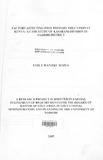| dc.description.abstract | The thrust of this research project was an investigation into factors affecting Free Primary Education in Kenya; a case study of Kasarani Division in Nairobi District. Free Primary Education has attracted a lot of attention and its implementation was a landmark policy decision by the government of the National Rainbow Coalition (NARC) in January 2003. The country's education budget increased by 17.4% to a soaring 79.4 billion with 5.6 billion being allocated to the Free Primary Education Programme (FPE).
The objectives of the study were to: -
i)Investigate whether physical facilities (extra classrooms, workshops, desks, toilets, playground, land) affect implementation of Free Primary Education in Kenya.
ii) Establish whether learning resources i.e. textbooks, chalks, writing materials are pertinent to the delivery of Free Primary Education.
iii) Establish whether human resources i.e. availability of qualified teachers and other support staff affect Free Primary Education.
iv) Investigate the magnitude of financial handicaps in facilitating the above needs in Free Primary Education.
The study used the ex-post facto design, self-administered questionnaires and informal interviews in data collection Prior to the main study, a pilot study was conducted which led to the modification of the research instruments.
Descriptive statistics involving frequencies, percentages and pie charts were used to analyze the data. The study established there is an overwhelming need for physical
facilities and land for extension. There is need to enhance learning resources since
enrolment is a continuous phenomena. The government should be able to give guidelines on books required (yellow book) on time.
All participants conceded on the need for more teachers. In addition, there is need to hire more secretaries and clerks who ought to be well informed with the accounting procedures for proper financial management.
Finances should be increased to carter for continuous enrolment. And the disbursement should be streamlined so that it can come on time for proper planning. The study recommends that: -
•More money should given to enhance free primary education
•Pupils should foster a positive attitude towards their learning.
•The government should ensure that the funds are disbursed to carter for all pupils in order to avoid dropouts.
•Inspection should be intensified so as to maintain standards in schools.
The study also identified the following areas for further research:
•A similar study could be replicated to a larger sample to establish if similar results could be attained.
•Investigate the future of FPE in Kenya.
Investigate the gap in quality of education in private and public schools in the endeavour to joining higher institutions oflearning . | en |

